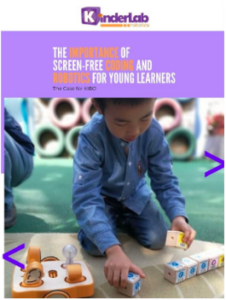Robotics for Kindergarten Students Brings STEM Fun to Classrooms, Makerspaces, Afterschool Programs, and Coding Clubs
In a world increasingly driven by and bound to technology, there is growing interest in getting children educated in a STEM/STEAM) at a younger age. Future job opportunities alone have grown exponentially in STEAM careers. One way to get started is by bringing robotics for kindergarten students for them to start to develop their STEAM and computational skills. Educational robots in the classroom, makerspaces, afterschool programs, and coding clubs can start these young learners on their journey into coding and programming.
However, most robotics for kindergarten students include screen-time, with coding and programming instruction provided online. Studies by Jama Pediatrics have correlated excessive screen time with several negative developmental and physical side effects such as the development of interpersonal interaction and problem-solving skills can be slowed when a child is spending over an hour a day on their devices.
Over-saturation at a young age can distract from burgeoning critical thinking skills. Having a plethora of games and apps on a tablet or phone provides more distraction than is helpful. It encourages multitasking at a stage where a child should be single-minded in their play and efforts.
It’s important to provide alternative solutions where young learners can get off the screens while developing these key STEAM skills. Provide robotics for kindergarteners where they are engaged with technology during learning and play.
Meet KIBO – Screen-free Robotics for Kindergarten Students
Enter KIBO, a research-based screen-free way for young learners to engage and learn with STEAM robotics. Using programmable wooden building blocks and their imagination, kids create a progamming sequence, decorate, and code their own robot.
What KIBO Robotics for Kindergarten Offers:
- A coding and robotic platform that can be easily integrated into existing curriculum or classroom projects, such as literacy, social studies, science, math, and art curricula.
- STEAM learning to meet your early learning Computer Science standards.
- Over 160 hours of standards-aligned STEM curriculum and teaching materials to ensure success when implementing KIBO in classrooms.
- Easy to implement lesson plans and fun play-based activities.
- Training and support in integrating robotics into classrooms with a wide range of cross-curricular connections to literacy, community, dance, science, and more!
KIBO robotics for kindergarten students help these young children start their journey into creating with code in a fun and creative way. KIBO’s block-based coding language gives children control over the robot’s movements, sounds, and sensors, allowing them to express their imaginations through code. The curriculum available teaches children to tell stories, create characters, and explore the world around them through code.
Learn the 6 Key Benefits of Using Robotics with Your Youngest Students!
![]() Introduce coding and robotics into your early childhood classrooms – in a fun and playful way!
Introduce coding and robotics into your early childhood classrooms – in a fun and playful way!



















